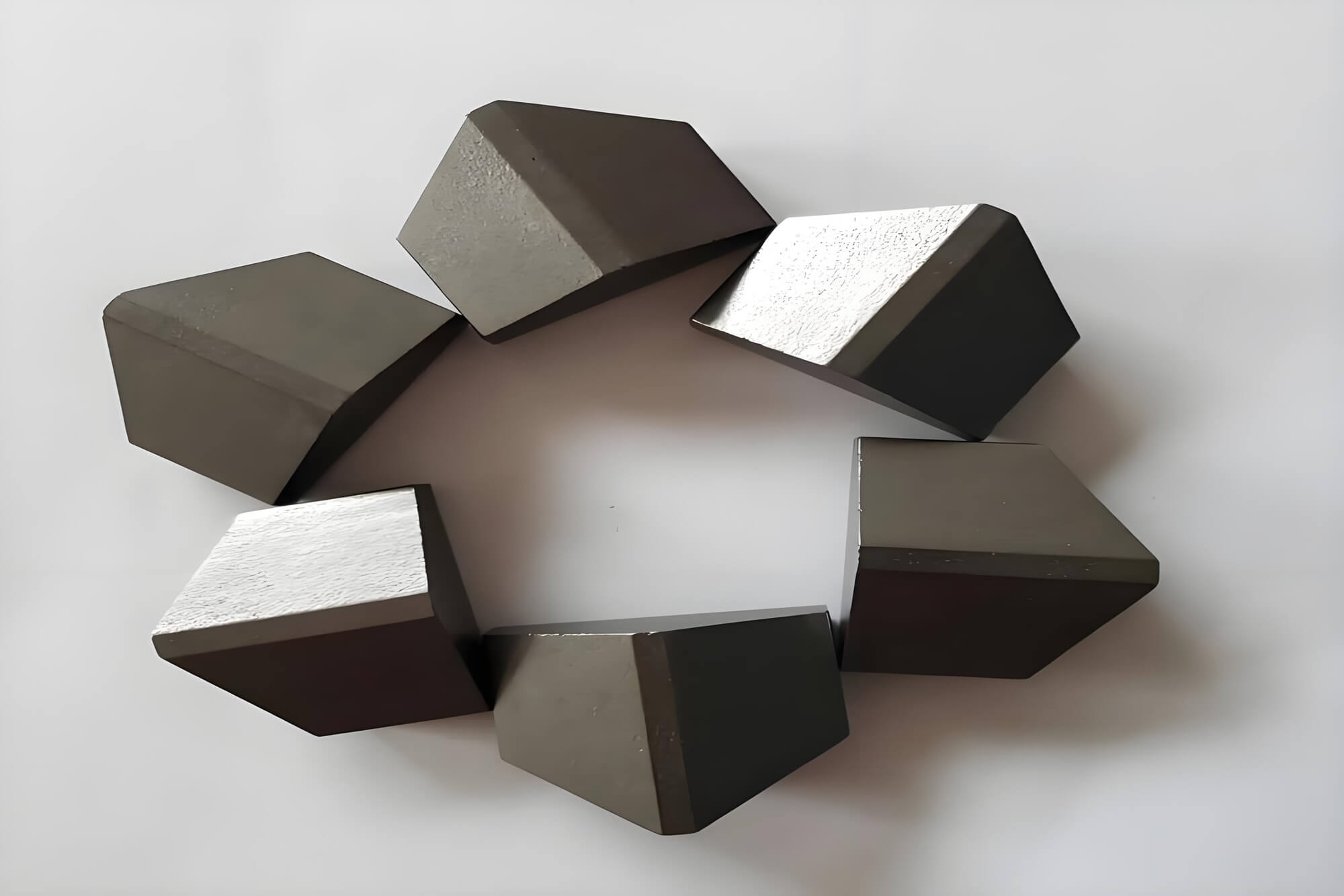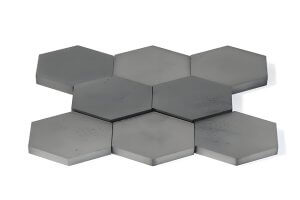Part 1: The Material Science of Cemented Carbide: The Core of CNC Machining
As a machinist with 15 years of experience, I’ve come to appreciate cemented carbide as the unsung hero of CNC machining. Its ability to withstand intense conditions while delivering precision has revolutionized my work. Let’s explore what makes carbide so vital, from its composition to its engineering.
1.1 Unpacking Cemented Carbide: A Composite Marvel
Cemented carbide is a metal matrix composite that pairs hard tungsten carbide (WC) particles with a cobalt (Co) binder. The carbide particles provide exceptional hardness, resisting wear during high-speed CNC machining, while cobalt adds toughness to prevent cracking. In my shop, I’ve seen how adding carbides like titanium carbide (TiC) or tantalum carbide (TaC) enhances performance, especially when machining tough steels, by improving heat resistance and reducing crater wear. This balance is what makes carbide tools indispensable for demanding jobs.
1.2 From Powder to Precision: Crafting Carbide Tools
The creation of carbide tools is a process I find mesmerizing. Powder metallurgy is used because carbide’s high melting point—far beyond traditional casting—demands it. It begins with milling WC and cobalt powders into a slurry, which is spray-dried into uniform granules. These are pressed into a “green compact” and sintered at 1300-1500°C, where cobalt melts to bind the carbide particles, forming a dense, durable material. I once toured a facility where this happened, watching raw powders transform into tools that power CNC machining. The sintered carbide is then precision-finished with diamond grinding or EDM, ensuring it meets the exacting standards of modern machining.
1.3 Engineering Carbide: Balancing Hardness and Toughness
The brilliance of carbide lies in its tunable properties, a lesson I’ve learned through countless machining projects. Cobalt content and WC grain size are the levers. Higher cobalt (10-25%) boosts toughness, perfect for roughing or interrupted cuts in CNC machining, while lower cobalt increases hardness for fine finishing. Finer grains (<1µm) enhance wear resistance, ideal for precision work, while coarser grains (>3µm) handle impacts in heavy-duty tasks. Early in my career, I botched a job by using a too-brittle carbide grade for a roughing task—switching to a tougher grade saved the day and taught me the importance of this balance.
Part 2: Carbide in the Tooling Landscape: A Competitive Edge
Choosing the right tool material for CNC machining is a decision I make daily. Here’s how carbide compares to its rivals, based on my hands-on experience.
2.1 Carbide vs. High-Speed Steel (HSS)
Carbide’s superior hardness allows cutting speeds 4-12 times faster than HSS, making it my go-to for high-volume CNC machining. Its heat resistance keeps tools sharp longer under intense conditions. However, HSS’s toughness shines in shaky setups or manual operations where carbide might chip. I recall a project on an old lathe where HSS outperformed carbide due to poor machine rigidity—a rare but humbling moment.
2.2 Carbide vs. Ceramics
Ceramic tools are harder and thrive in high-temperature finishing of hardened steels, but their brittleness limits them to stable, continuous cuts. Carbide’s versatility makes it my choice for most CNC machining tasks, from roughing cast iron to semi-finishing stainless steel. Ceramics are a niche player, while carbide is the all-rounder.
2.3 Carbide vs. Superhard Materials (PCD & CBN)
Polycrystalline Diamond (PCD) and Cubic Boron Nitride (CBN) are the elite of tooling, far harder than carbide. PCD dominates non-ferrous materials like aluminum, but its reactivity with ferrous metals makes it unsuitable for steels. CBN excels in hardened steels (>45 HRC), but both are costly and brittle. I reserve them for specialized CNC machining jobs, relying on carbide for 90% of my work due to its cost-effectiveness and durability.
Table 2.1: Tool Material Comparison for CNC Machining
| Material | Hardness (HV) | Toughness | Max Temp (°C) | Application | Limitation |
| HSS | ~800 | High | ~600 | General, interrupted cuts | Low speed, wears quickly |
| Uncoated Carbide | 1000-1900 | Medium | ~800 | Cast iron, non-ferrous | Limited at high speeds |
| Coated Carbide | 2300-3300 | Med-High | 800-1000+ | High-speed steel, superalloys | Coating choice critical |
| Ceramics | 1800-2500+ | Low | 1200+ | Hard steel finishing | Brittle, not for roughing |
| CBN | 4500+ | Low | 1000+ | Hardened steel (>45 HRC) | Costly, brittle |
| PCD | 7000+ | Low | ~700 (ferrous) | Non-ferrous, composites | Costly, not for ferrous metals |
Source: Adapted from Sandvik Coromant (2024).
Part 3: Mastering Carbide Tools in CNC Machining
Using carbide tools effectively is a craft I’ve refined over years. Here’s my guide for machinists looking to optimize their setup.
3.1 Decoding Carbide Grades: The ISO System
The ISO system is a lifesaver, classifying carbide grades by workpiece material: P (steels), M (stainless), K (cast irons), N (non-ferrous), S (superalloys), and H (hard materials). Numbers like P10 (hard, for finishing) or P40 (tough, for roughing) guide selection. I always double-check the ISO code to ensure my carbide tool matches the material and operation, saving time and avoiding costly mistakes.
3.2 The Carbide Toolbox: Tools for Every Job
Carbide Turning Inserts: These indexable inserts are my workhorse for lathes, offering multiple edges for cost efficiency. I select shapes and chipbreakers based on whether I’m roughing or finishing.
Carbide End Mills: For milling tasks like slotting or contouring, I choose flat-end for general use or ball-nose for 3D shapes. High-flute carbide mills have been a game-changer for chatter-free aluminum cuts.
Carbide Drills: These outshine HSS in speed and longevity. Through-coolant carbide drills are my pick for deep holes in titanium, keeping chips clear and temperatures low.
3.3 Fine-Tuning Feeds and Speeds
Optimizing feeds and speeds is where intuition meets data. I start with charts but adjust based on chip color and machine sound. For example, aluminum allows blazing speeds (1000-3000+ SFM), but titanium requires slower speeds and robust coolant. A recent job machining stainless steel taught me to lower feeds slightly to extend carbide tool life significantly.
Table 3.3.1: Starting Parameters for Carbide End Mills
| Material | Diameter (mm) | Coating | Speed (SFM) | Feed (IPT) | ADOC | RDOC |
| Aluminum (6061) | 12 | DLC | 1000-3000+ | 0.004-0.008 | 1.5xD | 0.25xD |
| Low-Carbon Steel | 12 | TiAlN | 400-800 | 0.003-0.005 | 1xD | 0.20xD |
| Stainless Steel | 12 | TiAlN | 250-450 | 0.002-0.004 | 0.5xD | 0.10xD |
| Titanium (6Al-4V) | 12 | TiAlN | 150-300 | 0.002-0.003 | 1xD | 0.08xD |
Source: Kennametal (2025). Adjust for machine and strategy.
Part 4: Pushing Carbide Performance in CNC Machining
4.1 Coatings: Armoring Carbide Tools
Coatings like TiAlN act as a shield, boosting carbide tool life by reducing friction and heat. I’ve seen TiAlN-coated carbide mills last 40% longer in high-speed steel jobs. PVD coatings are my preference for milling, as they keep edges sharp, while CVD suits heavy-duty turning.
4.2 Tool Geometry Matters
Tool geometry—rake angles, relief angles, chipbreakers—drives performance. Positive rake angles work for soft materials, while negative ones strengthen carbide edges for hard ones. I once fixed a chip-clogging issue in stainless steel by switching to a carbide insert with a sharper chipbreaker, cutting cycle time by 15%.
4.3 Troubleshooting Carbide Tool Problems
Premature Wear: Lower speed or choose a harder carbide grade. Better coolant flow saved a recent alloy job.
Chipping: Reduce feed or use a tougher carbide grade. Shortening tool overhang fixed a milling breakage.
Chatter: Stiffen the setup. A shorter carbide mill eliminated chatter on a tricky part.
Built-Up Edge: Increase speed and use low-friction coated carbide tools, especially for aluminum.
Part 5: The Future of Carbide in CNC Machining
5.1 Market Momentum
The carbide tools market is booming, fueled by industries like aerospace and electronics. CNC machining’s shift to automation demands high-performance carbide solutions, a trend I see daily in my work.
5.2 Cutting-Edge Innovations
Nano-crystalline carbide substrates and multi-layer coatings promise greater durability. I recently tested a 3D-printed carbide tool with internal cooling channels, which cut titanium machining time by 25%. Smart tools with sensors for real-time monitoring are next, poised to revolutionize CNC machining precision.
My Perspective: Carbide’s Lasting Impact
Carbide has been my trusted ally through countless projects. Its versatility lets me tackle aluminum to superalloys with confidence. A standout moment was machining an aerospace component under a tight deadline; a TiAlN-coated carbide insert reduced cycle time by 30%, saving the job. For reliable carbide tools, I turn to platforms like want.net, which offers a curated selection that’s streamlined my sourcing process.
Conclusion
Cemented carbide’s engineered balance of hardness and toughness powers CNC machining’s precision and efficiency. With advanced coatings, optimized geometries, and innovations like smart tools, carbide remains at the forefront of manufacturing. Ready to elevate your CNC machining? Explore top-tier carbide tools at want.net to boost your shop’s performance.
FAQ:
Q1: What makes cemented carbide so effective for CNC machining?
A: Cemented carbide’s effectiveness in CNC machining comes from its unique composite structure, blending hard tungsten carbide particles with a tough cobalt binder. This balance delivers exceptional hardness for wear resistance and toughness to handle demanding cuts. In my experience, carbide tools consistently outperform alternatives like HSS in high-speed applications, making them ideal for precision and efficiency.
Q2: How do I choose the right carbide grade for my CNC machining project?
A: Use the ISO classification system to match the carbide grade to your workpiece material (e.g., P for steels, K for cast irons) and operation type (e.g., P10 for finishing, P40 for roughing). I’ve found that checking the ISO code and consulting with suppliers, like those on want.net, ensures the right carbide tool for the job, saving time and reducing tool wear.
Q3: Why do carbide tools sometimes fail prematurely in CNC machining?
A: Premature failure often stems from incorrect speeds, feeds, or carbide grades. For example, excessive speed can cause wear, while high feeds may lead to chipping. I’ve faced this when machining stainless steel—adjusting to a tougher carbide grade and optimizing coolant flow fixed the issue. Always tailor parameters to the material and setup.
Q4: How do coatings improve carbide tool performance in CNC machining?
A: Coatings like TiAlN reduce friction and enhance heat resistance, extending carbide tool life. In a recent job, switching to a TiAlN-coated carbide mill increased tool life by 40% when cutting alloy steel. PVD coatings are great for milling, while CVD suits heavy-duty turning, based on my shop floor tests.
Q5: Can carbide tools be used for all materials in CNC machining?
A: Carbide is versatile but not universal. It excels in most materials, from aluminum to superalloys, but struggles with extremely hard materials (>45 HRC), where CBN is better, or highly abrasive composites, where PCD shines. I rely on carbide for 90% of my CNC machining tasks due to its balance of cost and performance.
Q6: What’s the cost-benefit of using carbide tools vs. HSS in CNC machining?
A: Carbide tools cost more upfront but offer higher cutting speeds and longer life, reducing downtime and tool changes. For a high-volume job, I found carbide cut production time by 25% compared to HSS, justifying the investment. For low-rigidity setups, though, HSS might be more economical.
Q7: How are innovations shaping the future of carbide tools in CNC machining?
A: Innovations like nano-crystalline carbide substrates and 3D-printed tools with internal cooling channels are boosting performance. I tested a 3D-printed carbide tool recently, cutting titanium cycle time by 25%. Smart tools with sensors for real-time monitoring are also emerging, promising even greater CNC machining efficiency.
Q8: Where can I source high-quality carbide tools for CNC machining?
A: Reliable platforms like want.net offer a wide selection of carbide tools, from inserts to end mills. I’ve used want.net to source TiAlN-coated carbide tools for a recent aerospace project, streamlining my workflow with their quality options and fast delivery.
Reference:
https://zh.wikipedia.org/wiki/%E7%A2%B3%E5%8C%96%E9%8E%A2
https://www.wikiwand.com/zh/articles/%E7%A2%B3%E5%8C%96%E9%8E%A2
https://www.britannica.com/science/carbide
https://patents.google.com/patent/CN109312479B/zh
Other Articles You Might Enjoy
- Silicon Carbide and CNC Machining: A Comprehensive Technical Analysis of Materials, Processes, and Applications
Introduction Silicon carbide (SiC) stands as a pinnacle of advanced ceramics, engineered to thrive in environments that push materials to their limits. Its extraordinary hardness, thermal resilience, and chemical stability…
- Tooling Considerations for CNC Machining: Solid Carbide vs. High-Speed Steel
Introduction: Brief Explanation of CNC Machining - Overview of Solid Carbide and High-Speed Steel Tools Computer Numerical Control (CNC) machining is a broad term for procedures employed in manufacturing processes…
- Can Precision CNC Machining Compensate for Material Weaknesses in High-Stress Applications?
The Role of CNC Machining in Material Enhancement In engineering applications where materials are subjected to high stress, the choice and treatment of materials are crucial for the integrity and…
- High-Speed CNC Machining Parts: The Secret Sauce of Tool Material Selection
To high-speed CNC machining, the selection of tool materials is crucial. Imagine you're a chef preparing a gourmet meal; the ingredients you choose will significantly impact the final dish. Similarly,…
- Precision CNC Machining of Steel: High-Volume Production
Precision CNC Machining and High-Volume Production As an integral part of modern manufacturing processes, Precision Computer Numerical Control (CNC) machining brings about unmatched accuracy and consistency in the production of…






